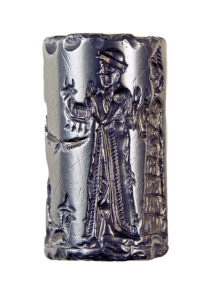Featuring a computer generated recreation of the ancient city of Babylon, of which the remains of the city are in present-day Hillah, Babil Governorate, Iraq, about 85 kilometers south of Baghdad. Even though only a small portion of the ancient city (3% of the area within the inner walls; 1.5% of the area within the outer walls; 0.05% at the depth of Middle and Old Babylon) has been excavated much is theorized about the ancient city.
The Magnificent Ancient City Of Babylon
A previously unknown Chaldean chieftain “Nabopolassar” allowed Babylon to escape Assyrian rule, and in an alliance with Cyaxares, king of the Medes and Persians together with the Scythians and Cimmerians, finally destroyed the Assyrian Empire between 612 BC and 605 BC. Babylon thus became the capital of the Neo-Babylonian (sometimes and possibly erroneously called the Chaldean) Empire.
According to Professor Dietz-Otto Edzard, the city was originally called Babilla
With the recovery of Babylonian independence, a new era of architectural activity ensued, particularly during the reign of his son Nebuchadnezzar II (604–561 BC). Nebuchadnezzar ordered the complete reconstruction of the imperial grounds, including the Etemenanki ziggurat, and the construction of the Ishtar Gate—the most prominent of eight gates around Babylon. A reconstruction of the Ishtar Gate is located in the Pergamon Museum in Berlin.
Nebuchadnezzar is also credited with the construction of the Hanging Gardens of Babylon—one of the seven wonders of the ancient world—said to have been built for his homesick wife Amyitis. Whether the gardens actually existed is a matter of dispute. German archaeologist Robert Koldewey speculated that he had discovered its foundations, but many historians disagree about the location. Stephanie Dalley has argued that the hanging gardens were actually located in the Assyrian capital, Nineveh.
Nebuchandnezzar is also notoriously associated with the Babylonian exile of the Jews, the result of an imperial technique of pacification, used also by the Assyrians, in which ethnic groups in conquered areas were deported en masse to the capital. Chaldean rule of Babylon did not last long; it is not clear whether Neriglissar and Labashi-Marduk were Chaldeans or native Babylonians, and the last ruler Nabonidus (556–539 BC) and his co-regent son Belshazzar were Assyrians from Harran.

Old Babylonian cylinder seal, hematite. This seal was probably made in a workshop at Sippar (about 40 miles north of Babylon on the map above) either during, or shortly before, the reign of Hammurabi.[25] It depicts the king making an animal offering to the Sun god Shamash.
The Persian Conquest
In 539 BC, the Neo-Babylonian Empire fell to Cyrus the Great, king of Persia, with a military engagement known as the Battle of Opis. Babylon’s walls were considered impenetrable. The only way into the city was through one of its many gates or through the Euphrates River. Metal grates were installed underwater, allowing the river to flow through the city walls while preventing intrusion. The Persians devised a plan to enter the city via the river. During a Babylonian national feast, Cyrus’ troops diverted the Euphrates River upstream, allowing Cyrus’ soldiers to enter the city through the lowered water. The Persian army conquered the outlying areas of the city while the majority of Babylonians at the city center were unaware of the breach. The account was elaborated upon by Herodotus[35][20] and is also mentioned in parts of the Hebrew Bible.
(Herodotus also described a moat, an enormously tall and broad wall cemented with bitumen and with buildings on top, and a hundred gates to the city. He also writes that the Babylonians wear turbans and perfume and bury their dead in honey, that they practice ritual prostitution, and that three tribes among them eat nothing but fish. The hundred gates can be considered a reference to Homer, and following the pronouncement of Archibald Henry Sayce in 1883, Herodotus’s account of Babylon has largely been considered to represent Greek folklore rather than an authentic voyage to Babylon. Dalley and others have recently suggested taking Herodotus’s account seriously again.)
According to 2 Chronicles 36 of the Hebrew Bible, Cyrus later issued a decree permitting captive people, including the Jews, to return to their own lands. Text found on the Cyrus Cylinder has traditionally been seen by biblical scholars as corroborative evidence of this policy, although the interpretation is disputed because the text only identifies Mesopotamian sanctuaries but makes no mention of Jews, Jerusalem, or Judea.
Under Cyrus and the subsequent Persian king Darius I, Babylon became the capital city of the 9th Satrapy (Babylonia in the south and Athura in the north), as well as a center of learning and scientific advancement. In Achaemenid Persia, the ancient Babylonian arts of astronomy and mathematics were revitalized, and Babylonian scholars completed maps of constellations. The city became the administrative capital of the Persian Empire and remained prominent for over two centuries. Many important archaeological discoveries have been made that can provide a better understanding of that era.
The early Persian kings had attempted to maintain the religious ceremonies of Marduk, but by the reign of Darius III, over-taxation and the strain of numerous wars led to a deterioration of Babylon’s main shrines and canals, and the destabilization of the surrounding region. There were numerous attempts at rebellion and in 522 BC (Nebuchadnezzar III), 521 BC (Nebuchadnezzar IV) and 482 BC (Bel-shimani and Shamash-eriba) native Babylonian kings briefly regained independence. However these revolts were quickly repressed and Babylon remained under Persian rule for two centuries, until Alexander the Great’s entry in 331 BC.
